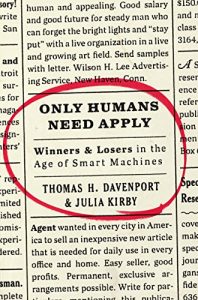 Only Humans Need Apply: Winners and Losers in the Age of Smart Machines
Only Humans Need Apply: Winners and Losers in the Age of Smart Machines
Thomas H. Davenport, Julia Kirby
In his most recent book, Tom Davenport, along with co-author Julia Kirby, provides an excellent entry point and framework for understanding the evolving relationship between smart people and smart machines. There’s a great deal of hand-wringing over technology encroaching on jobs of all sorts. This is hand-wringing that arises with every new technology innovation stretching back long before the days of Ned Ludd. Davenport and Kirby avoid the hand-wringing and take a close look at how today’s technologies—artificial intelligence, machine learning, etc.—are changing the way jobs are designed and structured.
They articulate their goal as
“to persuade you, our knowledge worker reader, that you remain in charge of your destiny. You should be feeling a sense of agency and making decisions for yourself as to how you will deal with advancing automation.”
In large part, they succeed. They do so by digging into a series of case histories of how specific jobs are re-partitioned, task by task, between human and machine. It’s this dive into the task-level detail that allows them to tell a more interesting and more nuanced story than the simplistic “robots are coming for our jobs” version that populates too many articles and blog posts.
Central to this analysis is to distinguish between automation and augmentation, which they explain as
“Augmentation means starting with what minds and machines do individually today and figuring out how that work could be deepened rather than diminished by a collaboration between the two. The intent is never to have less work for those expensive, high-maintenance humans. It is always to allow them to do more valuable work.”
They give appropriate acknowledgement to Doug Engelbart’s work, although the nerd in me would have preferred a deeper dive. They know their audience, however, and offer a more approachable and actionable framework. They frame their analysis and recommendations in terms of the alternate approaches that we as knowledge workers can adopt to negotiate effective partnerships between ourselves and the machines around us. The catalog of approaches consists of:
- Stepping Up—for a big picture perspective and role
- Stepping Aside—to non-decision-oriented, people centric work
- Stepping In—to partnership with machines to monitor and improve the decision making
- Stepping Narrowly—into specialty work where automation isn’t economic
- Stepping Forward—to join the systems design and building work itself
Perhaps a little cute for my tastes, but it does nicely articulate the range of possibilities.
There’s a lot of rich material, rich analysis, and rich insight in this book. Well worth the time and worth revisiting.